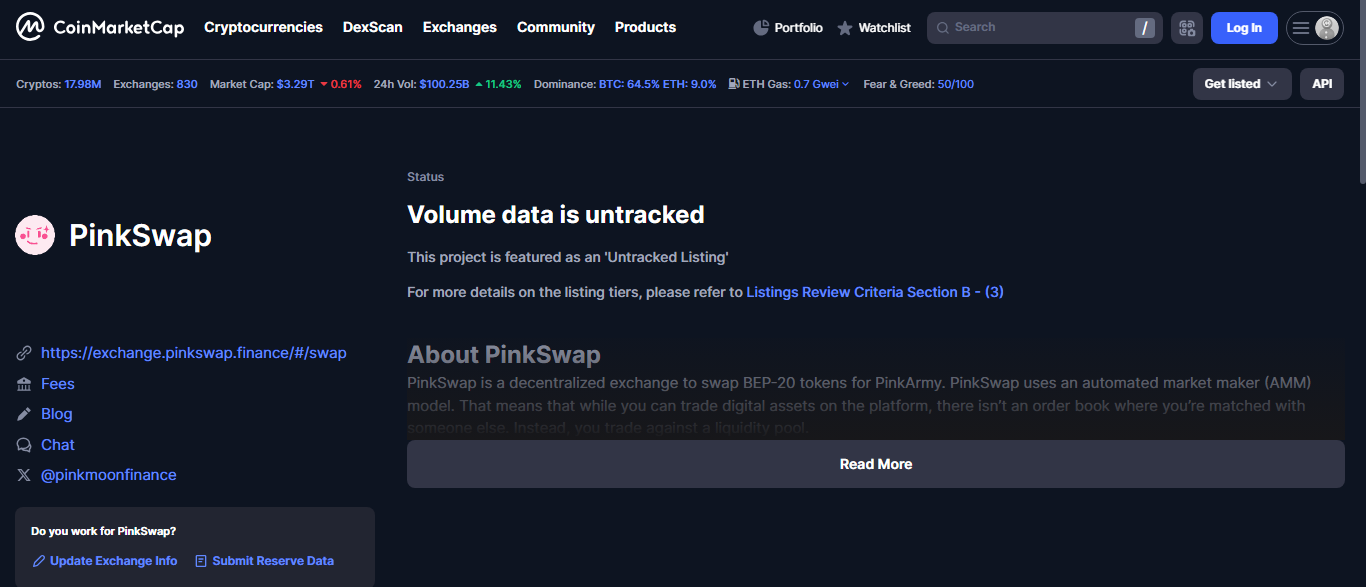PinkSwap Review - AMM on Cronos with yield ambitions, under-realized in practice

PinkSwap is a decentralized exchange and yield farming platform on the Cronos Network, offering token swaps, liquidity pools, staking vaults and cross-chain bridge options. It’s billed as an all-in-one DeFi hub with rewards, low fees and interoperability. In theory, it sounds like a versatile tool for cross-chain DeFi enthusiasts - but in reality, it feels like a well-intentioned experiment with limited impact.
A first look: polished visuals, shallow depth
When you first land on PinkSwap, you’re greeted by a crisp interface filled with token listings, pool tabs and yield vault sections. Wallet integration is straightforward, letting users swap and stake in minutes without opening an account or passing through KYC. Initial impressions suggest utility. But skim beneath the design and you’ll find liquidity indicators that barely budge, and vaults with few participants. It looks ready - but it doesn’t feel alive.
Ambitious value props, limited traction
At its core, PinkSwap tries to combine four main features:
- Token swapping with dynamically priced pools, similar to other AMMs across multiple chains.
- Liquidity staking, where users deposit tokens to earn trading fees plus occasional incentives.
- Farming vaults, offering extra yield by locking tokens in strategic pools.
- Cross-chain bridges, facilitating movement between Cronos and other networks.
That’s a robust mix. In concept, it’s a multi-tool portfolio for DeFi users. However, ambition runs into the reality of scale - without active users, even the best tools struggle.
Where it most clearly fails to deliver
Here’s where cracks show:
- Barely tapped liquidity: Most pools contain modest sums. Even modest trades can disrupt pricing, giving early users poor execution.
- Low daily volume: Activity is rarely above a few thousand dollars, and many days register near zero in trading.
- Sparse farming participation: Yield vaults often report few or no slots filled, suggesting limited user interest.
- Minimal security transparency: The platform mentions audits and claims cold storage, but no clear documentation or third-party verification appears publicly.
- Weak community signals: Social channels show minimal engagement and no firm roadmap, indicating lack of momentum.
Farming assets and staking rewards mean little if no one deposits. For now, PinkSwap is semi-functional - but only at micro scale.
Strengths that keep hope alive
That said, PinkSwap does bring some positive traits:
- Wallet-only access means you don’t need an account or personal data - just connect and use.
- Low transaction fees, leveraging the inexpensive Cronos gas environment.
- Cross-chain support allows movement between networks without intermediaries.
- Modular design separates swapping, staking and farming into clear UX sections.
- Early adopter potential: If it gains traction, early users could shape pools or protocols themselves.
These features appeal to a niche group of DeFi pioneers willing to engage with emerging ecosystems.
Who might use PinkSwap - and how
PinkSwap could fit a few profiles:
- DeFi tinkerers who enjoy bridging testnets, staking small tokens, and experimenting with new protocols.
- Cronos community members looking for native DeFi options on-chain without going off-platform.
- Yield curious explorers interested in token farming with pocket-sized stakes and early control.
But for anyone searching for stable income, liquidity, or consistent tools, this platform remains a beta experiment - not a production system.
When you should avoid it
Unless you’re in one of the above tiny groups, PinkSwap isn’t fit for serious use:
- Large-volume traders will face slippage, slow fills, and failed transactions.
- Institutional or risk-averse users need audits and governance clarity - not present here.
- Long-term investors wanting reserve guarantees and steady APR are better off on matured platforms.
- Users comparing DeFi hubs will find PinkSwap’s ecosystem lacking partnerships, integrations or depth.
In short: if it isn’t move-in-pocket small, this isn’t where you park it.
Snapshot table for quick clarity
Here’s a compact overview of the platform’s high and low points:
The final verdict
PinkSwap delivers a clean, modular platform with swapping, staking, farming and bridging built into Cronos. Wallet-only access and low fees make usage easy for explorers. But without liquidity or active users, it feels more like a sandbox than a marketplace.
If you’re a Cronos developer or Degen yield chaser staking pocket change, it can still offer some testing ground. But for functional trading, steady returns or rich DeFi interactions, better options exist. Treat this as an alpha-stage tool: poke it gently, don’t rely on it, and expect rough edges.
In DeFi, ambition is everywhere - but real momentum requires user adoption, volume, security and clarity. PinkSwap has the ambition - but not yet the execution.
Disclaimer
“This content is for informational purposes only and does not constitute financial advice. Please do your own research before investing.”
.png)







%203.svg)
%203.svg)




















